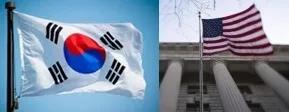Has South Korea Averted a Major Crisis with the US Tariff Agreement?

Synopsis
Key Takeaways
- Tariff reduced from 25% to 15%.
- US$350 billion investment commitment from South Korea.
- Impact on automotive and machinery sectors.
- Exports to the U.S. declined by 3.7% in the first half of 2025.
- Economic growth forecasted at 0.8% for the year.
Seoul, July 31 (NationPress) South Korea's recent tariff deal with the United States, on par with those achieved by its major trading competitors, is anticipated to offer immediate support to its export-oriented economy. However, experts caution that the nation must prepare for the ramifications of changing trade regulations on crucial sectors and the overall economy.
Earlier today, the two countries unveiled a bilateral trade agreement that establishes a 15 percent tariff on South Korean exports to the U.S., significantly lower than the previously anticipated 25 percent. The agreement also includes a commitment for US$350 billion in South Korean investments in U.S. shipbuilding, energy, and other industries, as reported by Yonhap news agency.
This arrangement also reduces tariffs on automobiles to 15 percent, down from the current 25 percent, while South Korea successfully evaded additional U.S. market access stipulations in sensitive areas like beef and rice. This new agreement is scheduled to come into effect on Friday (U.S. time).
"We have surmounted a considerable obstacle," President Lee Jae Myung expressed in a Facebook post. "This agreement dispels uncertainty in our export landscape and facilitates conditions to compete on equal or improved terms with leading nations."
Earlier in the week, the U.S. and Japan finalized a framework trade agreement with 15 percent tariffs, while the European Union also established a 15 percent levy. The export dynamics of Japan and the EU to the U.S. closely mirror that of South Korea.
Despite providing some respite, experts predict that the new tariff structure may further dampen South Korea's exports to the U.S. and other markets, at least in the short term.
In the first half of this year, South Korean exports to the U.S. decreased by 3.7 percent year-on-year, totaling $62.18 billion, as car exports plummeted by 16.8 percent and machinery sales contracted by 16.9 percent.
"Exports to the U.S. have been on a downward trend, with particularly sharp declines in automobiles and steel, both subject to specific tariffs. Our trade surplus with the U.S. is also diminishing," remarked industry ministry official Seo Ga-ram.
"The repercussions of U.S. tariffs are being felt more keenly in reality than the statistics indicate. Declining exports from China to the U.S. have also negatively affected our component exports to China," he added.
South Korea's overall exports slightly declined by 0.03 percent year-on-year during the first half of 2025, amounting to $334.7 billion, which still represents the third-highest export total for any first half, following those of 2022 and 2024.
Officials note that the unexpectedly strong first-half figures were, in part, due to front-loaded demand in anticipation of impending tariff increases.
A potential slowdown in exports is feared to further strain the domestic economy amid sluggish consumption.
"Starting in the third quarter, the effects of U.S. tariffs are likely to become more pronounced," stated Lee Dong-won, an official at the Bank of Korea (BOK). "Economic growth may decelerate further under the 15 percent tariff framework."
The central bank previously projected a 0.8 percent expansion for the local economy this year, following a 2 percent year-on-year growth in 2024.
In the second quarter, the nation's real gross domestic product (GDP) rose by 0.6 percent, recovering from an unexpected 0.2 percent contraction in the first quarter. The BOK is set to unveil its latest growth forecast for the year next month.
Companies are racing to evaluate the implications of the new agreement, amid escalating concerns that the trade benefits South Korea secured under its bilateral free trade agreement (FTA) with the U.S. may have been effectively undermined, particularly in the automotive sector.
South Korean automobiles had previously entered the U.S. market duty-free under the KORUS FTA, while Japanese and European vehicles faced a 2.5 percent tariff.
"We advocated for a 12.5 percent tariff until the final moments," stated Kim Yong-beom, the presidential chief of staff for policy. "However, insisting on 12.5 percent could have destabilized other agreements."
The presidential official added, "The FTA itself is already under considerable strain."









